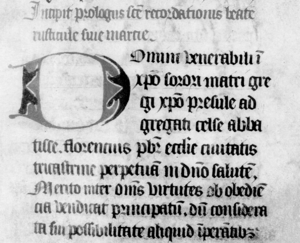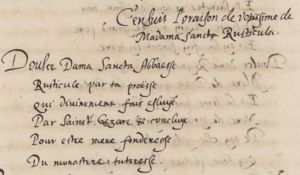Rusticula facts for kids
Rusticula (born around 556 – died August 11, 632), also known as Marcia, was a powerful leader of a convent called Saint-Jean d'Arles. She was the abbess (the head nun) from 575 until she passed away.
Rusticula came from a rich family. When she was a child, she was taken away by someone who wanted to marry her for her money. But she was rescued and brought to the abbey. Later, in 613, she was arrested because people thought she was involved in a plan against King Chlothar II. However, she was found innocent and set free. After she died, people honored her as a saint. Her life story was written down soon after her death.
Her Life Story
We know about Rusticula's life mainly from a book called The Life of Rusticula, or Marcia, Abbess of Arles. It was written in Latin by a priest named Florentius. He wrote it for Celsa, who became the abbess after Rusticula. Florentius might have grown up in the convent and been there when Rusticula died.
The oldest full copy of this book is from the 14th century. It is now kept in Paris. This book is a saint's life, which means it tells about a holy person's life and miracles. It says that Rusticula knew the entire Bible by heart. It also tells about several miracles she performed, especially when she was arrested and on her way back to Arles.
Early Life
Rusticula was born around 556 near Vaison. She came from a wealthy Gallo-Roman family. The book about her life says that "Rusticula" was her family name. Her family and the convent called her "Marcia." It is possible that Marcia was a special name she took when she became a nun. Her parents were Valerianus and Clementia. Her father died on the day she was born. The book says she was the only child to inherit her family's wealth.
When Rusticula was young, a man named Cheraonius took her away. He wanted to marry her to get her inheritance. But Liliola, the abbess of Saint-Jean, and Bishop Syagrius of Autun helped her. They spoke to King Guntram, who ordered her release. After this, Rusticula was allowed to join the abbey of Saint-Jean. Even though her mother asked for her back, King Guntram said no. This was because Rusticula had already promised to become a nun. She would have been at least six or seven years old at that time.
As Abbess
Rusticula was chosen to be the new abbess in 575, taking over from Liliola. She was said to carry a piece of the True Cross (a holy relic) with her. The book about her life says she led big building projects at the convent. It even says she helped carry stones to the workers herself!
After 613, the area where Rusticula lived came under the rule of King Chlothar II. At some point, Rusticula was accused of being part of a plan against the king. People might have thought she was too close to the previous kings, like Guntram.
The book says that a bishop named Maximus and a powerful leader named Ricomer first accused Rusticula. There was even an attempt to harm her. King Chlothar then ordered her arrest. The man sent to arrest her, Faraulf, threatened the local governor to make Rusticula surrender. Bishop Domnolus of Vienne spoke out against King Chlothar II for arresting her. This probably happened at a big meeting of church leaders in Paris in 614. Rusticula was able to prove her innocence in the king's court. She was then allowed to return to Arles.
Death and How She Was Honored
The book about Rusticula's life says she was 77 years old when she died. Most people believe she died in 632, even though the exact year is not in the book. She passed away on August 11 after a short illness. Florentius, who wrote her story, reported a miracle that happened after her death. A man who could not walk was healed after drinking water that had touched the bed where her body lay. This was seen as proof of her sainthood.
Rusticula's special day to be remembered is August 11. This day is listed in the Roman Martyrology, which is a list of saints. Her day is not celebrated in the main calendar of the Roman Catholic Church. However, she is mentioned in many prayer books from Provence from the 13th and 14th centuries. One prayer book from Arles from the early 14th century even has a short part of her life story.



